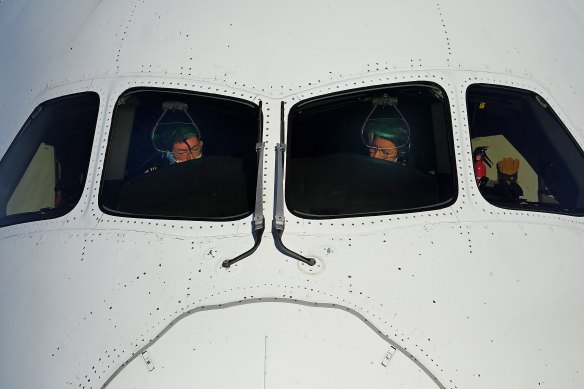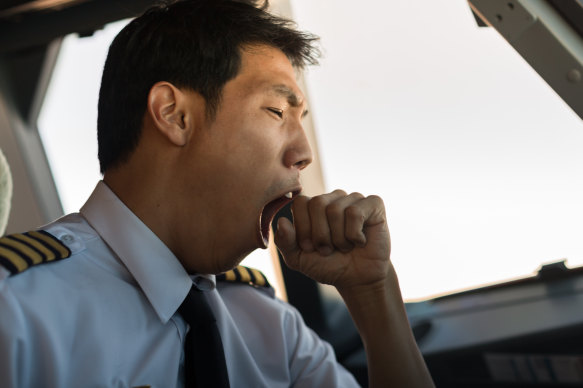
Aeroplane cockpits are full of alarms that sound when disaster is imminent. When I read yesterday of the push by some airlines for one-pilot cockpits despite safety fears, I was sure I could hear an alarm going off. Loud.
As a former Qantas captain, I’ve spent more than 40 years in the aviation business where safety is the number one focus. A major contributor to that safety record is a concept called redundancy, not the regrettable term that saw many pilots have their wings clipped because of COVID, but a technical term that continues to make commercial aviation the safest form of transport.
One-pilot cockpits are a very bad idea. Credit:Kate Geraghty
Redundancy is where there is a backup system to take over when a primary system fails. In all certified modern aircraft there are several levels of redundancies in every system.
The most recent exception was the Boeing 737 Max. In the interests of cost savings, the manufacturer failed to incorporate redundancy in their infamous Maneuvering Characteristics Augmentation System (MCAS) system. For those interested, the details are out there in a great Netflix doco called Downfall: The Case Against Boeing, however the point is that 346 humans paid the ultimate price for a lack of redundancy. The B737 Max was grounded until redundancy was incorporated into the software, which is now a very safe airliner.
The Airbus A380 I used to fly has five levels of braking redundancy: Normal, Alternate, Emergency, Ultimate … and when all else fails, the good old Parking Brake. You’re having a very bad day if your A380 runs out of brakes.
The Bombardier Global Express I now fly is a very sophisticated corporate jet. It has no fewer than six electrical generators. Two on each engine and another two on the auxiliary power unit (APU). Each one is capable of supplying enough electricity to power the essential systems to keep the aircraft flying.
One-pilot cockpits: what could possibly go wrong?Credit:iStock
I might also add that it’s fitted with a RAT, not the kind you stick up your snoz to test for COVID but a Ram Air Turbine – a small propeller that can be deployed into the airflow. When it spins up it can run the bare essentials of electricity and hydraulics to land. Oh, and there is also a battery, but I digress.
We also have at least two engines. If one fails the other is capable of continuing the take-off and bringing the aircraft safely back to earth. This is a drill practised by all qualified pilots over and over in the simulator, where there are at least two pilots.
Yes. Two pilots. For redundancy.
Pilots are human and, as such, make the odd mistake or errors of judgment. The other pilot is there to catch such slips and bring it to their colleague’s attention.
Safety has many layers in any modern business. James Reason came up with the “Swiss Cheese” model to demonstrate this. The analogy is that there are several safety layers to any organisation, however, these layers have holes in them like Swiss cheese. It’s when these holes line up that the slip can pass through and an incident or accident can occur.
In an aircraft, the last and most important layer of “Swiss Cheese” is the pilots. They are the last line of defence.
The travelling public has become conditioned over the past 20 years to accept the indignity of security checks before boarding any aircraft. You’re often required to remove several items of clothing, belts, jackets shoes etc before being subjected to a body scanner or metal detector. How would you feel if, in the interests of cost savings, this layer of “Swiss Cheese” was removed?
It was once said that “the most important piece of safety equipment onboard an aircraft is a well-trained, well-rested pilot”.
Make that two.
The Opinion newsletter is a weekly wrap of views that will challenge, champion and inform your own. Sign up here.
More original opinions
Poor little rich kids: There aren’t swathes of research on the woes of rich kids. There is some evidence they’re at greater risk of battling depression, anxiety and substance abuse, so why aren’t we talking about them more?
Morning checklist: There are three questions Jessica Irvine asks herself every morning, and if she can answer “no” to all three, it’s sure to be a good day.
Life’s golden rule: Being back in her old family home after a divorce and raising kids there was “beautiful agony” for Kate Halfpenny. That’s why she now never looks back.
Most Viewed in National
From our partners
Source: Read Full Article

